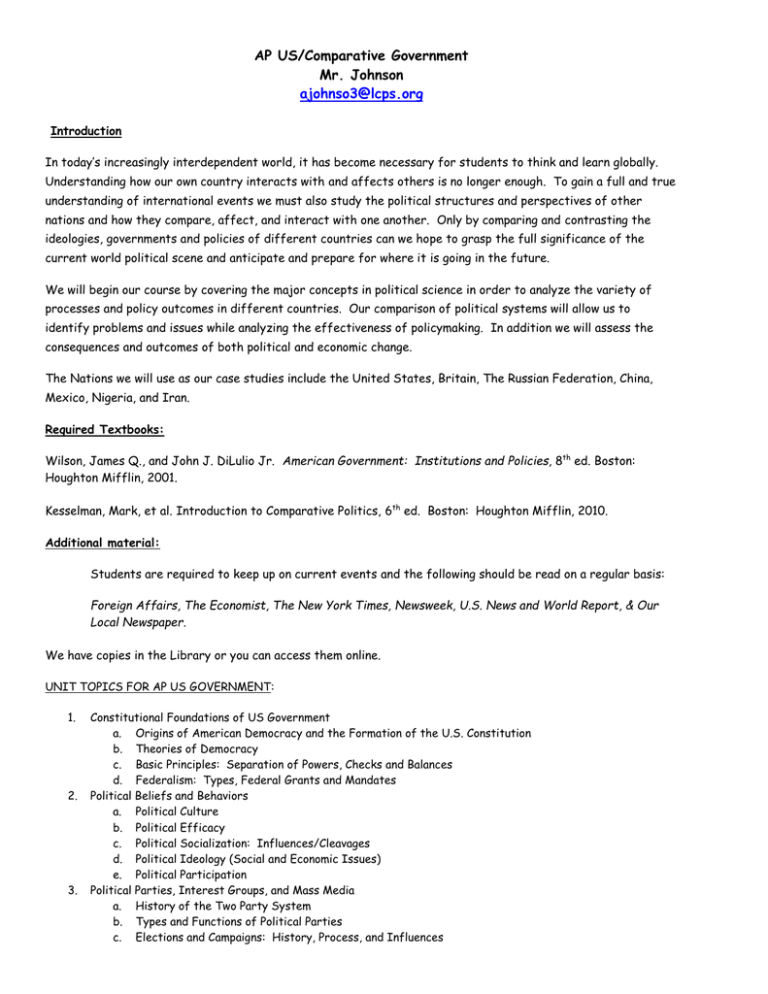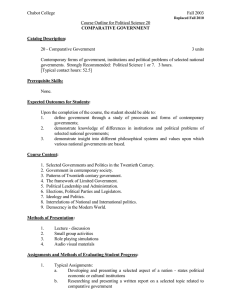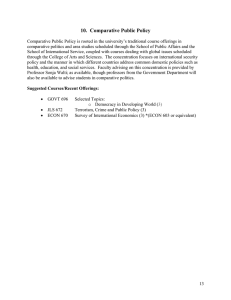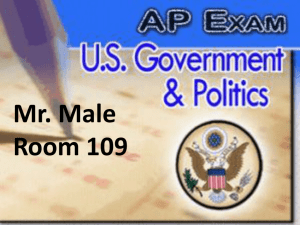AP US/Comparative Government Mr. Johnson
advertisement

AP US/Comparative Government Mr. Johnson ajohnso3@lcps.org Introduction In today’s increasingly interdependent world, it has become necessary for students to think and learn globally. Understanding how our own country interacts with and affects others is no longer enough. To gain a full and true understanding of international events we must also study the political structures and perspectives of other nations and how they compare, affect, and interact with one another. Only by comparing and contrasting the ideologies, governments and policies of different countries can we hope to grasp the full significance of the current world political scene and anticipate and prepare for where it is going in the future. We will begin our course by covering the major concepts in political science in order to analyze the variety of processes and policy outcomes in different countries. Our comparison of political systems will allow us to identify problems and issues while analyzing the effectiveness of policymaking. In addition we will assess the consequences and outcomes of both political and economic change. The Nations we will use as our case studies include the United States, Britain, The Russian Federation, China, Mexico, Nigeria, and Iran. Required Textbooks: Wilson, James Q., and John J. DiLulio Jr. American Government: Institutions and Policies, 8th ed. Boston: Houghton Mifflin, 2001. Kesselman, Mark, et al. Introduction to Comparative Politics, 6th ed. Boston: Houghton Mifflin, 2010. Additional material: Students are required to keep up on current events and the following should be read on a regular basis: Foreign Affairs, The Economist, The New York Times, Newsweek, U.S. News and World Report, & Our Local Newspaper. We have copies in the Library or you can access them online. UNIT TOPICS FOR AP US GOVERNMENT: 1. 2. 3. Constitutional Foundations of US Government a. Origins of American Democracy and the Formation of the U.S. Constitution b. Theories of Democracy c. Basic Principles: Separation of Powers, Checks and Balances d. Federalism: Types, Federal Grants and Mandates Political Beliefs and Behaviors a. Political Culture b. Political Efficacy c. Political Socialization: Influences/Cleavages d. Political Ideology (Social and Economic Issues) e. Political Participation Political Parties, Interest Groups, and Mass Media a. History of the Two Party System b. Types and Functions of Political Parties c. Elections and Campaigns: History, Process, and Influences 4. 5. 6. d. Interest Groups and PACS: Functions and Influence e. Mass Media: Functions and Influence on the Political System Institutions of National Government a. The Congress: Components and Powers b. The Presidency: Historical Development, Executive Branch, & Powers c. The Bureaucracy: Components, Powers, and Congressional Oversight d. The Judiciary: Historical Development, The Supreme Court, & The Federal Courts Civil Liberties and Civil Rights a. Historical Foundations b. The Amendments, Rights, & Social Change Public Policy a. Setting the Policy Agenda b. Domestic Policy (Social Welfare) c. Foreign Policy d. Economic Policy (Fiscal & Monetary-The Federal Reserve) UNIT TOPICS FOR AP COMPARATIVE GOVERNMENT: I. Introduction to Comparative Politics A. Purpose and methods of comparison and classification 1. Ways to organize government 2. Normative and empirical questions B. Concepts (state, nation, regime, government) C. Process and policy (what is politics; purpose of government; what is comparative politics; common policy challenges) II. Sovereignty, Authority, and Power A. Political culture, communication, and socialization B. Nations and states C. Supranational governance (e.g., European Union) D. Sources of power E. Constitutions (forms, purposes, application) F. Regime types G. Types of economic systems H. State building, legitimacy, and stability I. Belief systems as sources of legitimacy 1. Religion 2. Ideology (liberalism, communism, socialism, conservatism, fascism) J. Governance and accountability III. Political Institutions A. Levels of government 1. Supranational/national/regional/local 2. Unitary/federal 3. Centralization/decentralization B. Executives (head of state, head of government, cabinets) 1. Single or dual 2. President 3. Prime minister C. Legislatures 1. Unicameral/bicameral (symmetric/asymmetric) 2. Organization 3. Membership (representation) D. Parliamentary and presidential systems 1. Institutional relations E. Elections 1. Presidential 2. Parliamentary 3. Referendums 4. Noncompetitive F. Electoral systems 1. Proportional representation 2. Single member district (plurality, majority runoff) G. Political parties (organization, membership, institutionalization, ideological position) H. Party systems I. Leadership and elite recruitment J. Interest groups and interest group systems K. Bureaucracies L. Military and other coercive institutions M. Judiciaries 1. Degrees of autonomy 2. Judicial review (including European Union in relation to states, citizens) 3. Types of law IV. Citizens, Society, and the State A. Cleavages and politics (ethnic, racial, class, gender, religious, regional) B. Civil society C. Media roles D. Political participation (forms/modes/trends) including political violence E. Social movements F. Citizenship and social representation V. Political and Economic Change A. Revolution, coups, and war B. Trends and types of political change (including democratization) 1. Components 2. Promoting or inhibiting factors 3. Consequences C. Trends and types of economic change (including privatization) 1. Components 2. Promoting or inhibiting factors 3. Consequences D. Relationship between political and economic change E. Globalization and fragmentation: interlinked economies, global culture, reactions against globalization, regionalism AP Examination: The AP US Government Exam has 60 multiple choice questions (45 minutes) and 4 FRQs (100 minutes)—each counting as 50% of your grade. The AP Comparative Government Exam has 55 Multiple Choice questions (45 minutes) and 8 FRQs (100 minutes)— each counting as 50% of your grade. CLASSROOM EXPECTATIONS A. Class Attendance. All students are expected to be in class every day. If you have an excused absence, you are expected to make up the work as soon as possible. Please see me for work deadlines or extensions. B. Punctuality. All students are expected to arrive ON TIME. You are “on time” when you are in your seat when the late bell rings. Tardiness disrupts the classroom environment. Tardiness will be handled in accordance with the Park View High School guidelines. C. Preparation. All students are expected to come to class fully prepared. This includes: having assignments completed and ready to hand in, bringing all materials to class, and being ready (and excited) to learn! D. Materials. All students are expected to bring with them all materials needed for class. These materials include: E. F. 1. Binder or Spiral Notebook with sections (a place to put handouts!); 2. Notebook Paper (NO SPIRAL EDGES!); 3. Pen, Pencil, and highlighter; 4. Textbook; and 6. Planner. Homework. All students can expect to have homework after every class session. The length of the homework assignment may vary. Homework will be checked at the BEGINNING of class. If you do not have it, you will not get credit for it. A point will be deducted for every day a homework assignment is late. Free passes on homework is not how the real world operates. Classroom Behavior. All students entering the classroom will show respect toward the teacher and fellow classmates. Profanity, verbal, and/or physical abuse will not be tolerated! All other rules in the student planner will be enforced as well. G. Academic Integrity. BE HONEST! Any student caught cheating and/or plagiarizing will not receive credit for the assignment AND will be referred to the Administration. Academic dishonesty will be handled in accordance with the Park View High School guidelines. H. Assignments. I reserve the right not to accept late class assignments. If unexcused late work is accepted, it will be on a reduced credit basis. In the case of an excused absence, all students are expected to make up all work. Your extension is usually the number of days you missed. If you have any questions or concerns, please see me. All assignments must contain your name, class period, and date. NO NAME, NO GRADE. Some assignments require a typewritten format. If access to a computer or typewriter is difficult, please see me. All other written assignments should be in blue or black ink. I welcome the opportunity to work and learn with all of you. Remember that successful learning is a TWO-WAY street. You are encouraged to stop by and ask for assistance anytime! LET’S HAVE A GREAT YEAR! Student Signature:__________________________________






